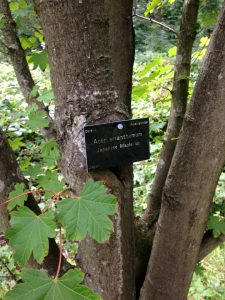Oak Survey with Tony Titchen – Part 1
On 12 August, we were met at the Arboretum by the renowned dendrologist, Tony Titchen, to start work on a survey of the various oaks we have.
Tony originally surveyed the arboretum in 2001 and created the listings that we are using to identify the trees today; he also identified his ‘top 21 trees‘ that you can read about on this website (most are in the arboretum, though some are on neighbouring land).
When Tony completed this work in 2001 he was as yet unaware of an old survey called Trees of Tortworth. Using this original survey, along with maps made by Alan Mitchell of the Forestry Commission based on that survey, Tony is now surveying what he believes to be one of the most interesting and varied collections of oak in the country.
These maps below, drawn by Alan Mitchell, show numbers and locations deduced from Trees of Tortworth. The Forestry Commission used this book as a guide; on the maps below, where there is a triangle, they have some doubt as to the correct identification from the original list.
While surveying the oaks we were able to visit some of the walnuts and wingnuts. We have both English (juglans regia) and Black (juglans nigra) and we looked at ways to identify them from the leaflet patterns as well as the bark.
Walnuts and wingnuts have an interrupted pith when you cut into the new growth of stem. Hickory (from the same family) are more or less solid throughout. Here we have a black walnut, juglans nigra, as well as evidence that the walnuts are appreciated by local wildlife.
We also searched out the wingnut with an unusual metal sign stating ‘pterocarya stenoptera’ or Chinese wingnut; this is incorrect, though we do not know whether the sign was placed by the wrong tree or whether the identification was wrong.
It is in fact pterocarya fraxinifolia, Caucasian wingnut. Fraxinifolia meaning leaves like an ash. Soon, this monoecious tree will have fantastic catkins up to 50cm long.
Here we are looking at the ‘wings’ on the stem to identify it.
We also identified a Spanish fir, abies pinsapo, an unusual tree from the south of Spain. One of the ways you can tell what it is, is through touch – the squeeze test. The spikes do not squash in your hand.
We have a large area covered with mare’s tail. Equisetum arvense – as identified by Tony Titchen. This native plant is invasive and crowds out less sturdy plants.
Below we also have a red oak acorn. Red and black oaks take 18 months to mature their acorns, and they gain tannins during this long period. White oaks on the other hand take just one season and were therefore used more commonly to make flour, with less tannins.
This red oak acorn is a redundant acorn; they have not matured and the tree has discarded them.
The last photo below is of a tree that is prolific in the woods neighbouring the arboretum. We believed it originally to be a sycamore (acer pseudoplatanus, or maple that looks like a plane tree) but with Tony Titchen’s help we have identified it as acer velutinum, or Persian maple, or velvet maple. Tell tale signs are the large leaf size and pinky stems on the leaves.

